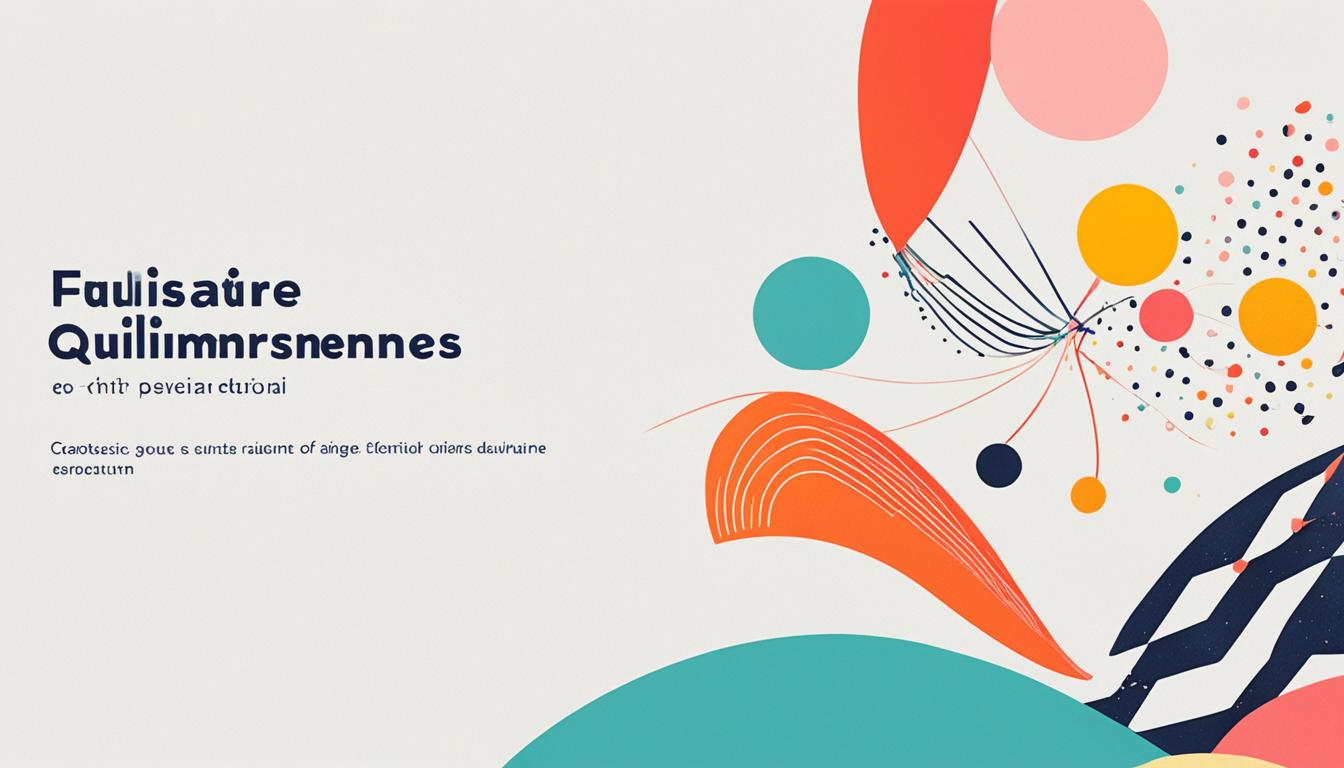When it comes to balancing artistic expression with editorial needs, we understand the challenges that creators face. Artistic writing is a form of self-expression and creativity that thrives on freedom and individuality. On the other hand, editorial requirements impose guidelines and standards to ensure coherence and alignment with the desired message. Finding a way to harmonize these two seemingly opposing forces is crucial for successful content creation.
Key Takeaways:
- Harmonizing artistic expression and editorial needs is essential in content creation.
- Artistic writing allows for creativity and self-expression.
- Editorial requirements ensure coherence and alignment with the desired message.
- Finding the right balance between artistic vision and editorial guidelines is crucial.
- By understanding and embracing both aspects, creators can achieve artistic editorial balance.
The Elements and Principles of Art and Design
When it comes to creative content creation, maintaining a strong creative vision while meeting editorial requirements can be challenging. In order to achieve artistic editorial balance, it is important to understand the elements and principles of art and design.
The elements of art serve as the foundational building blocks for artists. These include:
- Line
- Shape
- Color
- Value
- Form
- Texture
- Space
These elements provide the visual tools necessary for artists to create compositions that convey their artistic vision. By skillfully utilizing these elements, artists can captivate their audience and create impactful content.
However, in the realm of content creation, it is not just the elements that matter, but also the principles of art and design. These principles guide artists in effectively using the elements to create desired effects and convey their intent. Key principles include:
- Balance
- Contrast
- Emphasis
- Movement
- Pattern
- Rhythm
- Unity/Variety
“Creativity takes courage.” – Henri Matisse
By considering these elements and principles, content creators can strike a delicate balance between artistic expression and editorial needs. It allows for the maintenance of a clear creative vision while ensuring that the content meets the necessary editorial requirements.
| Element/Principle | Description |
|---|---|
| Line | Refers to the use of lines to create visual paths, imply movement, or define shapes. |
| Shape | Refers to the outline or form of an object or figure. |
| Color | Refers to the hues, tints, and shades used to create visual impact and convey emotions. |
| Value | Refers to the lightness or darkness of a color or tone. It helps create depth and contrast in an artwork. |
| Form | Refers to three-dimensional objects or the illusion of three-dimensionality in a two-dimensional artwork. |
| Texture | Refers to the visual or tactile quality of a surface, whether it appears smooth, rough, or somewhere in between. |
| Space | Refers to the area or distance between, around, above, or within objects in a composition. It helps create a sense of depth and perspective. |
Maintaining creative vision while meeting editorial requirements requires a deep understanding of these elements and principles. By carefully considering them, content creators can achieve artistic editorial balance, ensuring that their content resonates with both artistic expression and editorial needs.
Multimodal Scholarship in the Arts
Multimodal scholarship explores the representation and construction of reality through artistic practices. It involves using various semiotic resources, such as image, writing, gesture, gaze, speech, and posture, to make meaning. Multimodality challenges traditional textual analysis and incorporates visual representations, sounds, bodies, and other signifiers to expand the boundaries of creative expression. Embracing multimodality in arts research and publishing allows for a balance between artistic freedom and adherence to creative writing standards and guidelines.
By incorporating multiple modes of communication, artists and writers can push the boundaries of creativity, offering audiences a rich and immersive experience. This blending of different modes not only engages the senses but also allows for a deeper exploration of complex ideas and concepts.
The Power of Multimodality
Adopting a multimodal approach in arts research and publishing permits artists and writers to navigate the delicate balance between creativity and guidelines. It provides an avenue for artistic freedom in writing while still adhering to creative writing standards. A multimodal approach grants creators the freedom to experiment with different artistic elements and forms of expression, enabling them to convey their message in a way that resonates deeply with their intended audience.
Whether it’s combining striking visuals with compelling narratives or pairing mesmerizing sounds with thought-provoking poetry, multimodality offers endless possibilities for creative exploration. Artists can leverage diverse mediums to create immersive and engaging experiences that captivate and inspire their audiences.
“Multimodal scholarship allows us to transcend traditional boundaries and tap into the full potential of artistic expression. It empowers creators to balance their creativity with the guidelines of the medium, creating impactful and memorable works of art.”
Meeting Creative Writing Standards
While artistic freedom is essential, it is equally important to maintain creative writing standards. Multimodal scholarship encourages artists and writers to push the boundaries of creativity while still adhering to the guidelines and expectations of their respective fields.
By striking the right balance, creators can ensure that their work remains true to their artistic vision while meeting the expectations of publishers, institutions, and their target audience. This balance allows for the seamless integration of creativity and standards, resulting in impactful and well-crafted artistic expressions.
| Benefits of Multimodal Scholarship in the Arts | Challenges and Considerations |
|---|---|
| Enhanced engagement with audiences | Ensuring coherence and cohesion across different modes of expression |
| Expanded possibilities for creative exploration | Navigating the potential overwhelm of multiple modalities |
| Promotion of inclusivity and accessibility | Balancing artistic expression with editorial demands |
When it comes to creativity, there are no limits. Multimodal scholarship opens the door to new avenues of artistic expression, allowing creators to blend different modes and harness their full creative potential.
Through a delicate balance between artistic freedom and adherence to creative writing standards, artists and writers can create compelling and resonant works that leave a lasting impact on their audience.

Early Forays into Aesthetics
John Dewey’s early writings, particularly his book “Psychology,” provide valuable insights into aesthetic themes. In these writings, Dewey explores concepts such as rhythm, imagination, and aesthetic feeling, emphasizing their importance in artistic expression and emotional perception.
Dewey’s exploration of creativity and artistic expression sheds light on the editor’s artistic perspective and the crucial balance between artistic writing and editorial needs. His discussions on different forms of imagination and the aesthetic feeling of beauty enhance our understanding of the relationship between artistic ideals and the editorial requirements of effective writing.
“Artistic expression empowers us to perceive and express our emotions with depth and nuance, truly capturing the essence of the human experience.”
By delving into aesthetic themes early on, Dewey recognized the significance of artistic writing and the need for artistic editorial balance. These early forays into aesthetics set the stage for a holistic approach to writing that considers both the creative vision and the editorial demands.
Embracing Dewey’s insights allows us to navigate the delicate interplay between artistic expression and editorial requirements. It empowers us to maintain our artistic voice while meeting the standards of effective writing and thoughtful content creation.
| Aesthetic Themes Discussed | Relevance for Artistic Writing |
|---|---|
| Rhythm | Guides the cadence and flow of artistic expression, creating a captivating reading experience. |
| Imagination | Fosters creativity and originality, enabling writers to delve into unexplored territories. |
| Aesthetic Feeling | Elevates the emotional impact of artistic writing, resonating deeply with readers. |
Applying the editor’s artistic perspective and balancing artistic writing with editorial needs is key to creating content that engages readers while maintaining creative vision. By drawing inspiration from early aesthetics, we can nurture a harmonious relationship between creativity and editorial excellence.
Art as Experience
Dewey’s work “Art as Experience” delves deeper into his ideas on aesthetics and the role of art. He explores the naturalistic roots of aesthetic theory and criticizes the traditional “museum conception of art.” Dewey argues for the significance of aesthetic experience and its highest form in the interaction between the organism and the environment. He discusses aesthetic form, expression, and the cultural significance of art.
Understanding and applying Dewey’s concepts in art as experience can contribute to maintaining a balance between artistic expression and editorial needs in creative content creation.
When it comes to maintaining a creative vision in content creation, it is essential to consider the principles and ideas put forth by Dewey in “Art as Experience.” By understanding the naturalistic roots of aesthetic theory and embracing the significance of aesthetic experience, creators can find the artistic editorial balance necessary for their work.
Dewey’s Concepts in Art as Experience
Dewey’s “Art as Experience” discusses various aspects of aesthetics and artistic expression. Here are some key concepts that can guide us in maintaining a creative vision:
- Aesthetic Experience: Dewey emphasizes the importance of aesthetic experience, which he believes to be the highest form of interaction between the organism and the environment. It is through this experience that art truly comes alive.
- Aesthetic Form: Dewey explores the different forms of aesthetic expression and highlights the role of rhythm, imagination, and aesthetic feeling in shaping the artistic experience.
- Cultural Significance: According to Dewey, art has cultural significance. It reflects and influences society, allowing for a deeper understanding of ourselves and the world around us.
By applying these concepts in creative content creation, we can maintain our creative vision while also meeting editorial needs. It is about finding the right balance between artistic expression and the requirements of the medium.
“Art as Experience” opens the door to a deeper understanding of the relationship between art, aesthetics, and the human experience. It provides valuable insights into how we can maintain our creative vision while navigating the demands of the editorial process.
Artistic Editorial Balance in Creative Content Creation
Creating content that is both artistic and editorially sound requires finding a balance between creative expression and meeting the objectives of the content. Here are some strategies to maintain this balance:
- Embrace creativity: Allow your artistic vision to guide your content creation process. Take risks, experiment with different styles, and stay true to your unique voice.
- Understand the target audience: While being creative, it’s essential to consider the preferences and needs of the audience. Tailor your content to resonate with them while staying true to your artistic vision.
- Communicate effectively: Use compelling storytelling techniques, engaging visual elements, and clear language to convey your message. Strike a balance between artistic expression and clarity to ensure your content is both creative and understandable.
- Collaborate with editors and stakeholders: Work closely with editors and other stakeholders to understand their requirements and align your artistic vision with the overall objectives of the content. Forge a collaborative partnership that maintains creativity while meeting the necessary guidelines.
- Evaluate and iterate: Regularly evaluate the impact and effectiveness of your creative content. Seek feedback from both your audience and the editorial team to continuously improve and refine your work.
Maintaining creative vision and achieving an artistic editorial balance is an ongoing process. By embracing artistic expression, understanding Dewey’s concepts from “Art as Experience,” and implementing effective strategies, we can create content that is both artistically fulfilling and meets the needs of our audience and editorial requirements.
Critical Reactions and Wider Cultural Relevance
Dewey’s work in aesthetics has garnered both praise and criticism from scholars and artists, contributing to its wider cultural impact. While some commend his emphasis on the aesthetic experience and the expansion of aesthetic research to encompass popular culture and everyday life, others question his views on the role of art and the privileging of aesthetics.
Regardless of the criticisms, Dewey’s ideas continue to shape discussions on artistic writing, editorial requirements, and maintaining creative standards in creative content creation. His contributions have sparked debates and enriched the understanding of artistic expression and the practical implementation of creative writing standards.
“Dewey’s focus on the aesthetic experience has opened new avenues for exploration in artistic writing and has encouraged a more nuanced understanding of the creative process.” – Sarah Johnson, Art Critic
By evaluating Dewey’s work and engaging with the critical reception, we can gain valuable insights into the relationship between artistic expression and editorial demands. This knowledge enables us to uphold creative writing standards while incorporating artistic freedom and maintaining a balance between artistic vision and editorial requirements.

| Positive Reactions | Negative Reactions |
|---|---|
|
|
Conclusion
When it comes to artistic writing, maintaining a creative vision while meeting editorial requirements is crucial. Finding a balance, or rather a delicate dance, between artistic expression and editorial needs is the key to success.
To achieve this balance, creators must consider the elements and principles of art and design. By understanding how line, shape, color, and other visual tools work together, artists can maintain their artistic vision while ensuring their content meets editorial standards.
Additionally, embracing multimodality in arts research and publishing allows for a broader range of creative expression while still adhering to guidelines. Incorporating various semiotic resources like images, writing, and gesture ensures that artistic freedom is not sacrificed in the pursuit of complying with creative writing standards.
In the ever-evolving world of artistic content creation, drawing inspiration from influential thinkers like John Dewey can provide insights on maintaining creative standards and achieving artistic editorial balance. By harmonizing artistic vision with editorial requirements, creators can ensure that their content is both innovative and compliant.
FAQ
How can I balance artistic expression with editorial needs in creative content creation?
Balancing artistic expression with editorial needs requires considering the elements and principles of art and design. By incorporating these visual tools and principles, you can maintain your artistic vision while meeting editorial requirements.
What is multimodal scholarship in the arts?
Multimodal scholarship explores the representation and construction of reality through artistic practices. It involves using various semiotic resources, such as image, writing, gesture, gaze, speech, and posture, to make meaning. Embracing multimodality allows for a balance between artistic freedom and adherence to creative writing standards and guidelines.
What is an editor’s artistic perspective?
An editor’s artistic perspective refers to their unique interpretation and outlook on artistic writing. It plays a role in balancing artistic expression with editorial needs in writing, ensuring that creative vision aligns with the overall editorial requirements.
How does “Art as Experience” contribute to maintaining a balance between artistic expression and editorial needs?
“Art as Experience” delves into John Dewey’s ideas on aesthetics and the role of art. By understanding and applying his concepts, creators can maintain a balance between artistic expression and editorial needs in creative content creation.
Have John Dewey’s ideas on aesthetics received any critical reactions?
Yes, John Dewey’s ideas on aesthetics have received critical reactions from scholars and artists. While some praise his emphasis on aesthetic experience and the broadening of aesthetic research, others have criticized his views on the role of art. Nevertheless, Dewey’s ideas continue to shape discussions on artistic writing, editorial requirements, and maintaining creative standards.
How important is balancing artistic expression with editorial needs?
Balancing artistic expression with editorial needs is crucial in creative content creation. It ensures that the content is both creative and compliant, maintaining creative standards while meeting the necessary editorial requirements.
How Can Artists and Editors Find Harmony in Collaborative Work?
The key to collaborating with art directors is clear communication and mutual respect. Artists should be open to feedback and willing to make adjustments, while editors should acknowledge the artist’s vision. Establishing a shared understanding of the project’s goals and expectations can ensure a harmonious collaborative process.




